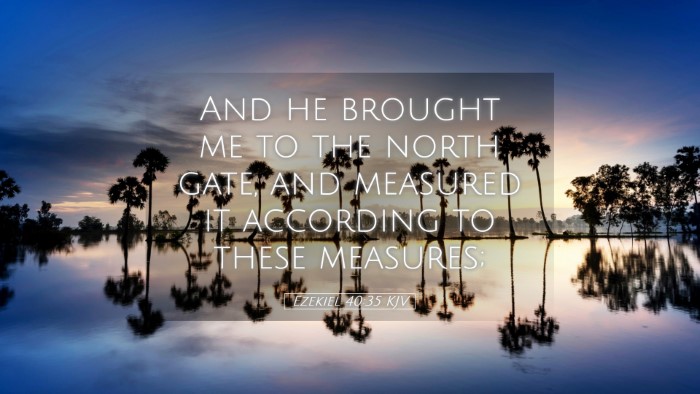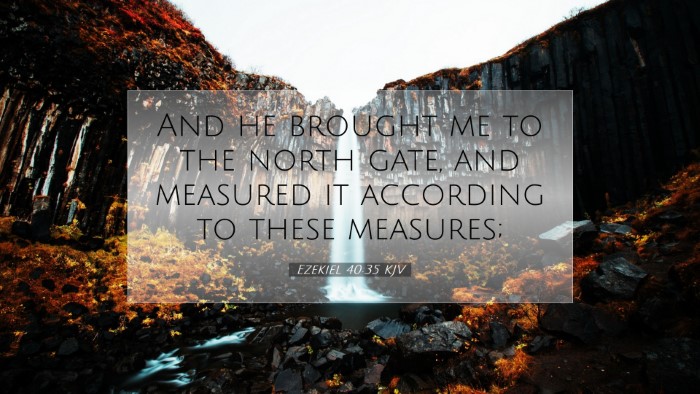Bible Commentary on Ezekiel 40:35
Ezekiel 40:35: "And the little chamber had the doors thereof toward the north, and the door of the little chamber was by the west." (KJV)
Introduction
The vision of the new temple in Ezekiel 40 represents not only a physical structure but also a profound theological message about God's presence among His people. This verse emphasizes the detailed and precise nature of the temple's construction, signifying the importance of spiritual order and divine habitation. As we explore insights from Matthew Henry, Albert Barnes, and Adam Clarke, we will uncover layers of meaning and application for today’s believers.
Exegesis of the Verse
Ezekiel 40:35 details the configuration of a specific chamber in the temple complex, highlighting the orientation of its entrance. The focus on the doors illustrates God's meticulous design for worship and communion. This verse invites deeper reflection on what it means for places designated for worship to reflect divine order.
Insights from Matthew Henry
Matthew Henry emphasizes the significance of the temple as a place of divine revelation and worship. He notes that the detailed arrangement of the temple's chambers serves as a metaphor for God's methodical approach to restoration. Henry states:
"The temple, in its features and functions, is a representation of the church, where God dwells among His people, and each part fulfills its role in worshiping Him."
Henry's reflections remind us that each door, each chamber, and all design features serve a purpose in facilitating access to the divine.
Insights from Albert Barnes
Albert Barnes elaborates on the structural arrangement described in Ezekiel, focusing on the theological implications of the temple's layout. He writes:
"The deliberate planning of the temple's doors symbolizes access — the journey of worshipers towards God, as well as the barriers that sin creates."
Barnes points out the symbolic nature of the doors, which leads believers to contemplate both the challenges of sinful living and the grace that allows entrance into God's presence.
Insights from Adam Clarke
Adam Clarke, known for his attention to detail, explores the architectural aspects of Ezekiel's vision. He states:
"The specific orientation of the little chamber's door towards the north suggests a thoughtful provision, signifying that the north in scripture often represents the place of judgment; thus, pointing to the necessity of facing the reality of sin before approaching God."
This evokes a deeper understanding of repentance and preparation as prerequisites for worship. Clarke's insight encourages believers to introspectively assess their spiritual standing.
Theological Implications
The description of the little chamber and its entrances serves to remind us of several key theological insights:
- God's Orderly Presence: The meticulous design of the temple reflects God's desire for order and holiness in worship.
- Access to the Divine: The orientation of doors symbolizes believers' journey to God, emphasizing both approachability and the need for reverence.
- Judgment and Grace: The north's symbolism invokes the reality of divine judgment, but simultaneously offers the grace that allows forgiveness and restoration.
Applications for Today
As we reflect on Ezekiel 40:35, several pertinent applications emerge for pastors, students, theologians, and Bible scholars:
- Worship as a Structured Experience: Just as the temple had designated areas for worship, Christian gatherings should maintain a focus on order, intention, and reverence.
- The Need for Preparation: Believers are encouraged to approach God with humility and readiness, reflecting on their spiritual state before worship.
- Understanding Judgment and Grace: The church today carries the message of both God's holiness and His grace, preaching to reconcile these dual aspects within the community.
Conclusion
Ezekiel 40:35 serves as a detailed reminder of God's desire for His people to approach Him in a manner that reflects His holiness and love. Through the insights of Matthew Henry, Albert Barnes, and Adam Clarke, we gain a richer understanding of the significance of order and structure in divine worship. As we engage with this verse, let us commit to fostering environments where worship is done in truth and spirit, reflecting God's character and inviting others into His presence.


